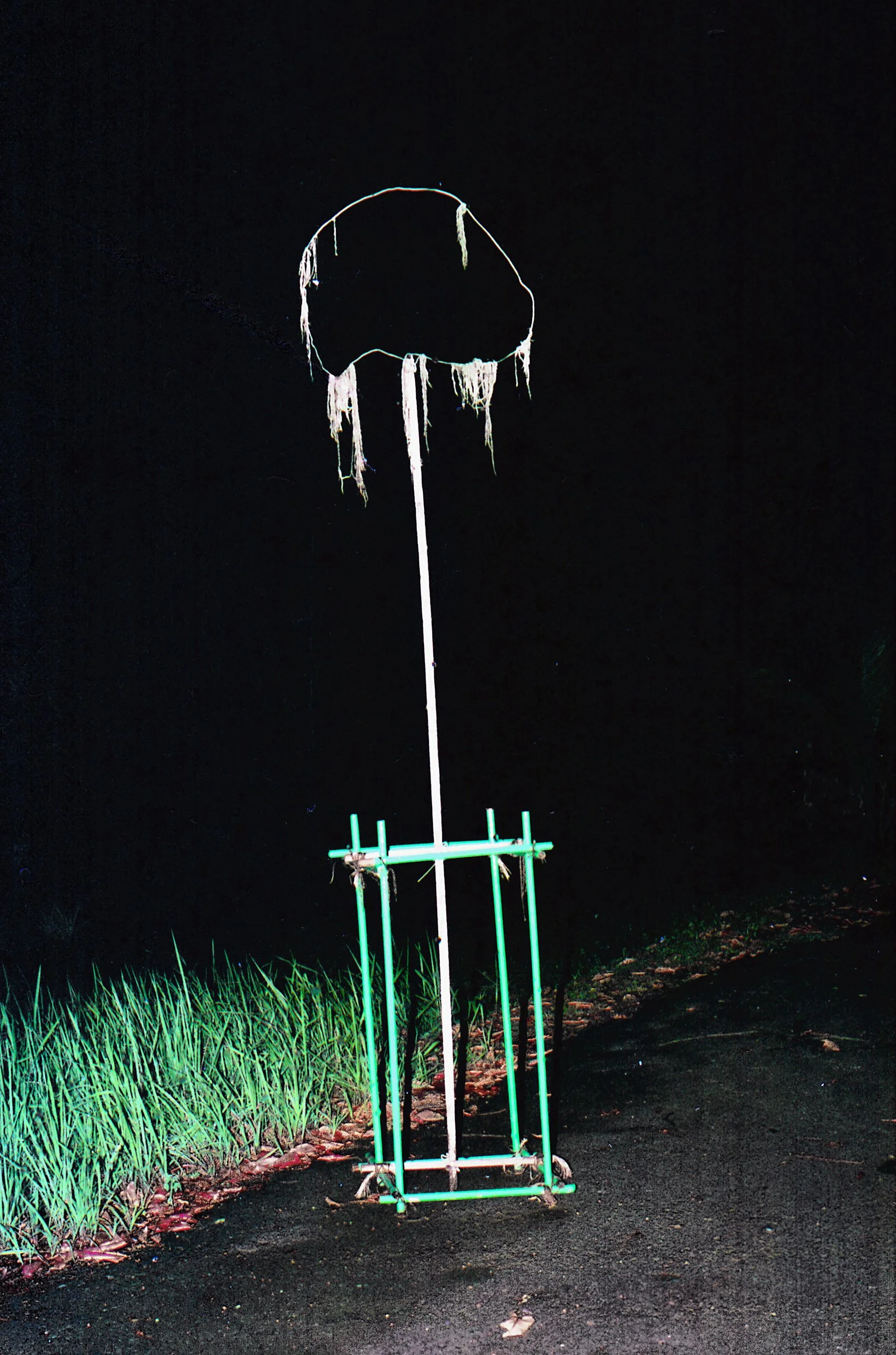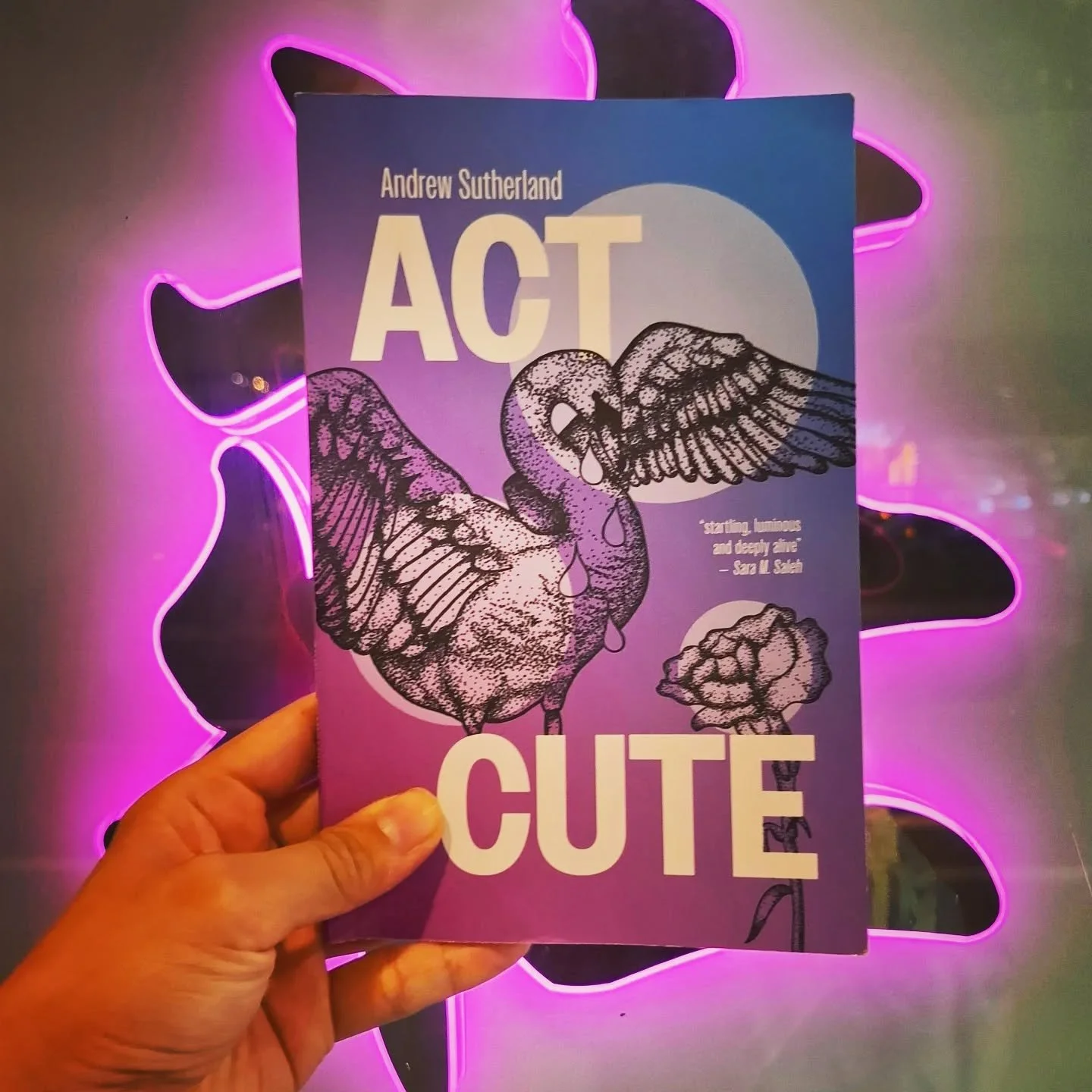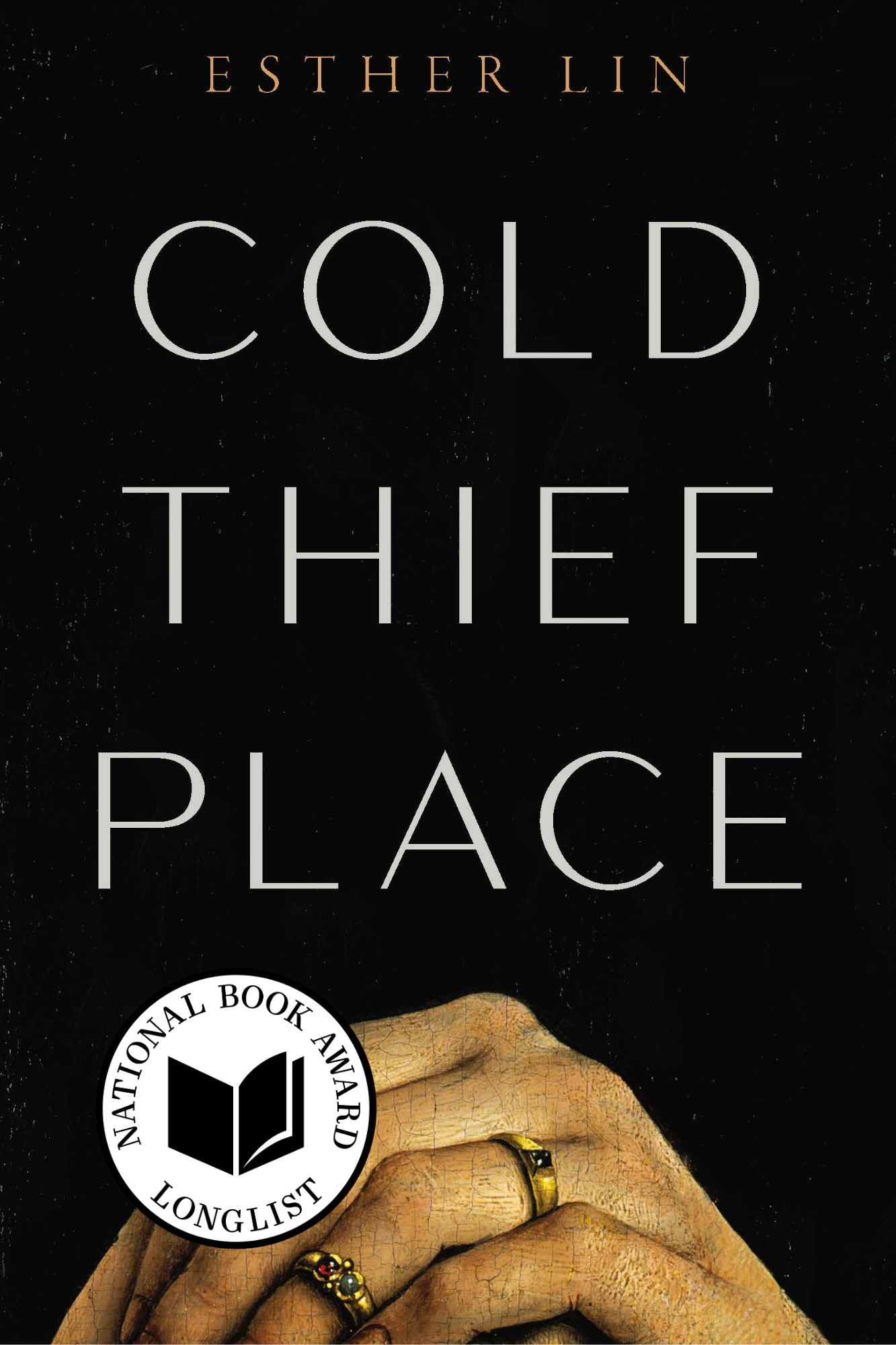A Cosmopolitan Kinship?
By Zining Mok
Review of Red Earth by Esther Vincent Xueming (USA: Blue Cactus Press, 2021)
Koh Nguang How - Hole in the Sky (1989)
Image description: An archival night photograph of a sculptural totemic tree, made of a long pole and a wire hoop from which hang scraps of fabric. The totemic tree is leaning against the trunk of another tree covered by moss. The trees are surrounded by broken chairs and potted plants.
By the time I cracked open my copy of Esther Vincent Xueming’s Red Earth, I had been chronicling my dream life, off and on, for over a year. I had never been one to remember my dreams, not until the pandemic, when my dream life became intensely vivid. My climate anxiety dreams were particularly striking in their heavy-handed symbolism: in one, I was in a penthouse at a bachelorette party while, outdoors, fires were ravaging the city of Chicago, where I used to live. “There’s a fire!” I tried to tell everyone, until my friend, the bachelorette, took me aside and said that I was ruining everything. For the rest of the party all I could manage to do was stare, just beyond the window, at the sky, still blue above the smoke that was rapidly consuming the city’s low-rises.
Encountering Vincent’s debut in this context, I was immediately drawn into the dream world of the collection’s opening poem, “Dream Fruit,” in which the speaker finds herself responsible for a tree and its fruit of gemstone. In the way we often do in dreams, she wanders off unknowingly, only to return to find the tree stripped:
….Too late, and though
she never blamed me, I wake up always guilty.
The pain of unspeakable loss:
my inconsolable grief, that striking heap.
These feelings of grief, guilt, and environmental alienation permeate the ensuing pages as the speaker contemplates images of ecological injustice, including a photograph of a roadkill sambar deer, a Little Guilin buried by asphalt and brick, and a “field overgrown / by another high-rise.”
The speaker’s guilt is one I know well, being, among other things, a citizen of a nation whose addiction to sand has contributed to ecological devastation in Southeast Asia. As a person, I wanted to know how I could live sustainably in Singapore; as a writer, I thought constantly about the politics and craft of eco-poetry. And thus I delved into Red Earth, each section of which—“Dream Fruit,” “About Love,” and “Pilgrims”—assembles images from everyday life, family history, dreams, and myths to ponder the ecological place of the human in the Anthropocene. The alternative to anthropocentric living, the collection suggests, is to develop intimate attachments—what Vincent calls “kinship”—between the human and the nonhuman. Writing and reading, the collection further suggests, are tools for developing such attachments, as they train one’s empathy and one’s ability to care for the things and beings of the earth.
I admire Red Earth’s attempt to portray what a sustainable ecopolitics built on kinship might look like. This is undoubtedly an urgent task that literature, with its capacity to imagine and to follow an idea to a logical end, is uniquely poised to do. Personally, however, I find the poems in Red Earth limited, both aesthetically and critically. The first few lines of “Albatross,” for instance, unfold almost too easily:
A country is hungry to expand her borders,
so she sucks on the fat of another’s land.
Machines like ravenous knives carve out tonne
after incessant tonne of sand, dredging the body
to the marrow.
Instead of jolting the reader into attention, the language here serves as an aesthetic filter, making the image of land reclamation all too digestible and consumable. Figuring sand mining as an act of vampiric exploitation that depletes the land of its vitality is graphic, but the familiarity of these figures of speech makes the poem lose its ability to make the reader pause, pay attention, and truly see the practices of land reclamation and how it relates to our daily lives.
Structurally, many poems in Red Earth are driven by image and meditation. This narrower range of modes may have in turn restricted the collection’s exploration of kinship. At the end of “Albatross,” for example, meditation turns the speaker’s attention inwards to elicit a confession: “To carry this albatross of guilt, my shame // of standing on another’s land, the weight / of a body that was never mine to own.” This move turns our attention back to the consciousness of the speaker rather than to the material realities of resource economics and ecological networks, or to nonhuman agency and human-nonhuman relations.
What does kinship look like, and what are the means by which we develop kinship? These questions were at the forefront of my mind as I read Red Earth. Sometimes, kinship in the collection looks like a figurative fusion. Instances of this fusion can be found in “Whale dream,” in which the speaker “dive[s] into the depths of [the whale’s] being”; “Red earth,” where the speaker parallels the earth’s deep wisdom with that of the human subconscious; and “About love, or a beautiful tree,” which weaves an intricate metamorphosis of the human body into tree, mineral, finally fossil. Elsewhere, kinship develops in the consciousness of the speaker. A good example is “Walk,” in which the speaker describes her dog’s eyes as “freckled and deep with knowing, soft / as they tell me this truth: Take your time, ready yourself. I am here / to guide you.” At best, these feel like meditative insights; a less generous reading might suggest that these moments are instances not of insight, but of projection.
Is meditation the most effective mode for developing kinship with the nonhuman? I am not entirely convinced. A more interesting, but underdeveloped, proposal might be found in the collection’s third section, “Pilgrims,” which seems to suggest that kinship can be formed via an ecological spirituality. This appears to be a contemporary form of eco-spirituality, one that combines a reverence for nature with non-traditional forms of spiritual engagement. (Non-traditional forms of spirituality are rarely affiliated with specific institutions. Rather than practicing prescribed rituals, an individual who subscribes to such spiritualities tends to assemble their own set of practices. In this light, we can perhaps view meditation as more than a mode in Red Earth: It could be indicative of an emerging eco-spiritual practice.)
Koh Nguang How - Rain Tree (1990)
Image description: An archival night photograph of a sculptural totemic tree, made of a tall white pole and a wire hoop from which hang scraps of fabric. The base consists of shorter green poles arranged in a square formation. The sculpture stands in the middle of a road, in front of an overgrown patch of grass.
In “Pilgrims,” the speaker turns from meditation to the ode—the mode of praise and reverence—as she undertakes pilgrimages to witness various natural sites, landscapes, and phenomena. This spiritual quest finally culminates in the closing poem, “Memory stone: in fragments.” Having returned home, the speaker assembles a sort of altar comprised of objects—such as pine cones from Dalat, a fragment of bleached coral from Mauritius, and a stone from Dubrovnik etched with the memory of weathering—which she has collected during her travels. These objects
…contain the history of home
away from home. Collected over time, they form
an ensemble of remembered places, a patchwork
of a traveller’s sojourn through lands of eternal
spring, snowless winters, of drifting along the Adriatic
into the ocean’s eye. Listen, undercurrents crash
beneath, waves breaking reef ashore.
Here, the speaker collects an archive of material objects that enables her to transcend a local and national understanding of home. Kinship, Vincent seems to be saying, can be a cosmopolitan concept, one that is facilitated not by familial ties or national identification, but spiritually, by the materials of the earth.
This understanding of kinship, cosmopolitan in its refusal to be bound by geographical borders, becomes particularly interesting when we consider earlier sections of the collection. Tracing her family tree, for instance, the speaker can compile only a “history // of [her] becoming in fragments. Three countries / and an ocean, harbouring lost stories of migration.” Bumping against the limits of memory, the speaker feels herself
An exile to [her] past, […] fill[ing] this void
with patchwork and guessing, [her] longing
bleeding from the margins of the page
into the tap root of [her] being.
In comparison, “Memory stone: in fragments” finds the speaker collecting an archive of her presence and movement on earth. I wonder, then, if Red Earth’s understanding of kinship represents less of a radical ecopolitics, and more of a response to the melancholia of diaspora.
Vincent’s debut adds to the slim but growing collection of Singaporean New Nature Writing, a genre that seeks to bear witness to contemporary ecological realities and to reimagine our relationships with place and nature. Recent Singlit titles that fall into this category include the anthologies Eating Chilli Crab in the Anthropocene and Making Kin (which Vincent edited), and, at the risk of tooting my own horn, The Orchid Folios, which untangles exotic and neocolonial narratives to illuminate the orchid as a hyperpersonal living thing. For me, both New Nature Writing in general and Red Earth in particular have reopened and recast questions that have always surrounded Singlit: what is the place of Singaporean writers in the global publishing market and in the contemporary world? To what extent should Singlit speak to global cultures and the threat of the climate crisis, and how should it do so?
Red Earth charts a personal journey from the local and regional to the transnational via family history, and from the transnational to the cosmopolitan via a spiritual orientation towards material objects and their relationship with the natural world. While the collection is wanting in texture, it does offer an intriguing response to the questions of human positionality by proposing eco-spirituality as a means of making kin on earth.
Koh Nguang How - Sun Tree (1990)
Image description: An archival photograph of a sculptural totemic tree, made of a tall white pole and a wire hoop from which hang scraps of fabric dyed red. Some of the red dye has also gotten on the pole.
Mok Zining is obsessed with random things: orchids, arabesques, sand. The Orchid Folios (Ethos Books, 2020) is her first book. She lives in Singapore, where she is at work on an essay collection, The Earthmovers.
*
Koh Nguang How was born in Singapore, 1963. He worked with the National Museum Art Gallery as curatorial assistant from Oct 1985 to Jan 1992. His artistic practice started in 1988 and encompasses photography, collage, installation, performance, documentation, archiving and curating. He is associated with the art collective The Artists Village since 1989. He started to make works using art archives in 1987 and started to exhibit art archives from 1992 in “Performance Week” at Gallery 21, Singapore. He initiated his “Singapore Art Archive Project” (SAAP) in 2005, subsequently presented more than 15 thematic works and exhibitions under the SAAP in Singapore and abroad.
If you’ve enjoyed reading this article, please consider making a donation. Your donation goes towards paying our contributors and a modest stipend to our editors. Singapore Unbound is powered by volunteers, and we depend on individual supporters. To maintain our independence, we do not seek or accept direct funding from any government.












This Christmas season, Ng Yi-Sheng takes us to the Middle East.